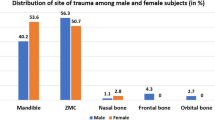Abstract
Introduction
Maxillofacial region is one of the most complicated arrangements of bony and soft tissues in human body, superiorly bounded by cranial bones and inferiorly by the mandible with interposed dentition. This is one of the reasons which make injuries to this region difficult to manage and often controversial. The severity and patterns of these injuries have changed considerably due to the increasing reliance on fast road transportation facilities and interpersonal violence.
Materials and methods
The aim of the present study is to analyze retrospectively the changing patterns of mid-face fractures in a sample of patients reporting to Department of Oral and Maxillofacial Surgery in AIIMS Bhubaneswar, India, from April 2017 to April 2018. A performa was prepared which included age, sex, etiology of injury, alcohol influence, and treatment given during hospital stay.
Results
Road traffic accidents contributed 68.11% of zygomaticomaxillary complex (ZMC) fractures, followed by assault (18.11%) and fall from height (13.76%). RTA was the major cause of atypical ZMC fractures as compared to conventional ZMC fractures (P < 0.001).
Discussion
Due to modern lifestyle and changes in fast transportation, recent fracture patterns do not follow the tell-tale signs or patterns and often need unique and patient-specific treatment plan, making the skills of maxillofacial surgeons the pivotal factor in better prognosis.






Similar content being viewed by others
References
Sharma R (2018) Re: Retroseptal transconjunctival approach for fractures of the zygomaticomaxillary complex: a retrospective study. Br J Oral Maxillofac Surg 56:435–436
Yamsani B, Gaddipati R, Vura N, Ramisetti S, Yamsani R (2015) Zygomaticomaxillary complex fractures: a review of 101 cases. J Maxillofac Oral Surg 15:417–424
Ashwin DP, Rohit, Rajkumar GC (2017) A study on assessing the etiology and different treatment modalities of zygomaticomaxillary complex fracture. Int J Contemp Med Res 4:1423–1430
Singaram M, Vijaybala GS, Udhayakumar RK (2016) Prevalence, pattern, etiology, and management of maxillofacial trauma in a developing country: a retrospective study. J Korean Assoc Oral Maxillofac Surg 42:174–181
Pandey S, Roychoudhury A, Bhutia O, Singhal M, Sagar S, Pandey RM (2013) Study of the pattern of maxillofacial fractures seen at a tertiary care hospital in North India. J Maxillofac Oral Surg 14:32–39. https://doi.org/10.1007/s12663-013-0578-4
Rajanikanth K, Borle D, Bhola D, Shivam D (2014) The pattern of maxillofacial fractures in central India A Unicentric retrospective study. IOSR J Dent Med Sci 13:28–31. https://doi.org/10.9790/0853-131102831
Ellis E, El-Attar A, Moos KF (1985) An analysis of 2,067 cases of zygomatico-orbital fracture. J Oral Maxillofac Surg 43:417–428. https://doi.org/10.1016/s0278-2391(85)80049-5
Dyer PV (1999) Experimental study of fractures of the upper jaw: a critique of the original papers published by René Le Fort. Trauma 1:81–84. https://doi.org/10.1177/146040869900100110
Funding
This research did not receive any specific grant from funding agencies in the public, commercial, or not-for-profit sectors.
Author information
Authors and Affiliations
Corresponding author
Ethics declarations
Conflict of interest
The authors declare that they have no conflict of interest.
Additional information
Publisher's Note
Springer Nature remains neutral with regard to jurisdictional claims in published maps and institutional affiliations.
Rights and permissions
About this article
Cite this article
Dikhit, P.S., Mohapatra, M., Jena, A.K. et al. Emerging Trends of Zygomaticomaxillary Complex Fractures and Their Etiological Analysis in a Tertiary Health Centre from Eastern India: A Retrospective Study. J. Maxillofac. Oral Surg. 20, 70–75 (2021). https://doi.org/10.1007/s12663-019-01295-w
Received:
Accepted:
Published:
Issue Date:
DOI: https://doi.org/10.1007/s12663-019-01295-w




